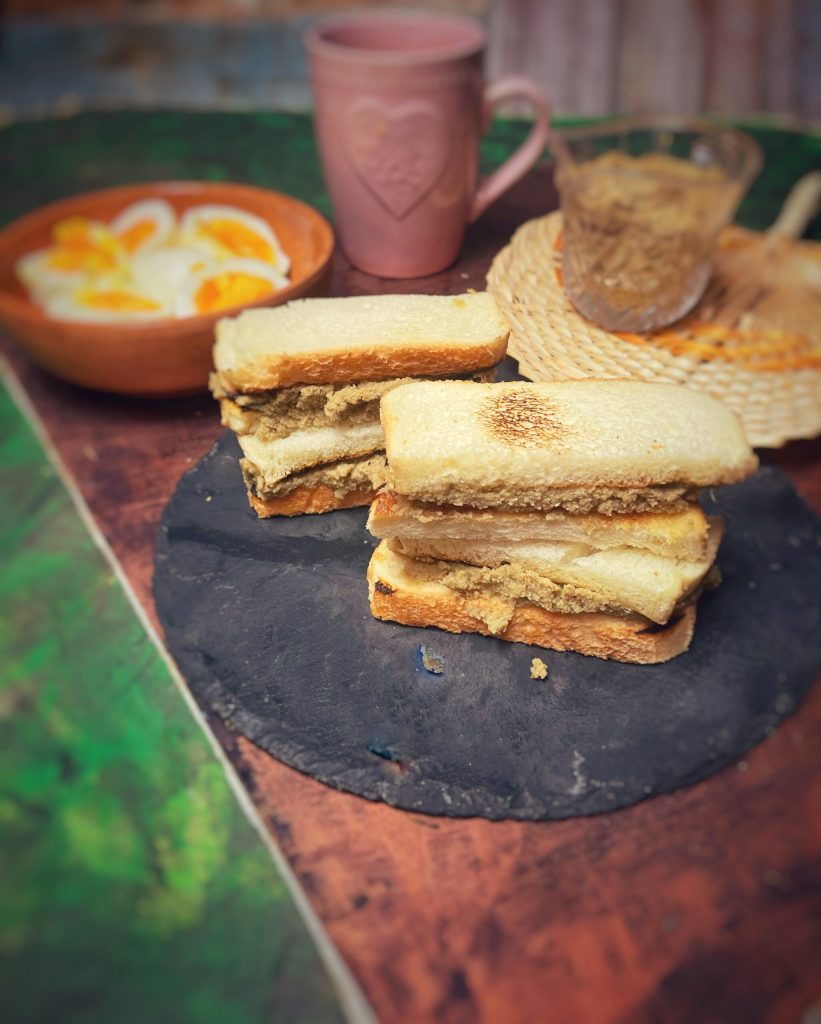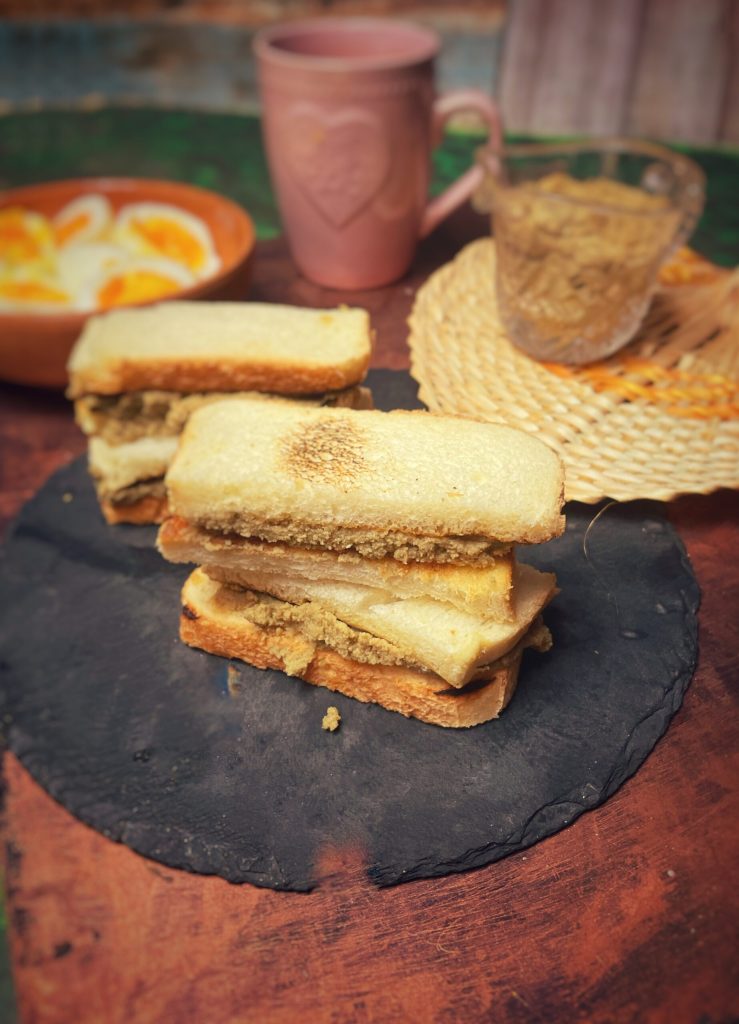Roti Bakar Kaya is a sweet toast typical of Malaysia and Singapore, very popular as a breakfast or snack.
The bread (generally brioche or sandwich loaf, sometimes toasted on a charcoal grill) is spread with Kaya, a sweet cream made from coconut milk, eggs, and sugar often flavored with pandan.
It is often served warm and cut in half or into small squares.
Traditionally, it is accompanied by soft-boiled eggs seasoned with soy sauce and white pepper, and a cup of strong coffee or tea (kopi or teh).
In modern versions, it can also be filled like a sandwich enriched with whole slices of salted butter, which melts between the warm bread and the kaya (also called Kaya Butter Toast).
Born between the early and mid-20th century, Roti Bakar Kaya is linked to the culture of kopitiams, the local cafes of the Chinese communities (Hainanese in particular) present in Malaysia and Singapore.
These cafes were popular places where the working class could have an affordable and nutritious breakfast.
Kaya takes inspiration from Portuguese or Dutch jams (during the colonial period), but it has been adapted with local ingredients: coconut and pandan.
The dish has become an identity symbol of Malaysian and Singaporean breakfast, today also reinterpreted in gourmet or fusion versions.

- Difficulty: Easy
- Cost: Economical
- Preparation time: 5 Minutes
- Portions: 4 People
- Cooking methods: Bain-marie
- Cuisine: Malaysian
- Seasonality: All seasons
Ingredients
- 4 eggs
- 7 oz sugar
- 1 pinch salt
- 1 cup coconut milk
- 1 teaspoon pandan powder (or pandan leaves)
- white bread (brioche type or sandwich loaf)
Steps
If using pandan juice:
Cut the pandan leaves into pieces and blend them with 2–3 tablespoons of water.
Strain the mixture with a fine sieve or cheesecloth to obtain the intense green juice.
In a bowl, lightly beat the eggs with the sugar until the sugar dissolves.
Add the coconut milk, pandan juice, and a pinch of salt. Mix well until smooth.
Pour the mixture into a heat-resistant saucepan.
Cook in a bain-marie over low heat, stirring continuously with a wooden spatula or whisk, for about 30–45 minutes, until the mixture thickens and becomes smooth and spreadable.
Let the kaya cool.
Toast the slices of bread on both sides until golden brown.
Generously spread the kaya on one slice of toasted bread.
Cover with another slice of toasted bread.
Cut the sandwich in half and serve warm.

FAQ (Frequently Asked Questions)
Are Sangkhaya and kaya the same thing?
Sangkhaya and kaya are not exactly the same, but they are very similar: they share main ingredients and appearance but come from different cultures and have slightly different uses and textures.
Kaya (Malaysia/Singapore)
Origin: Chinese-Hainanese culture in the regions of Malaysia and Singapore.
Main ingredients: coconut milk, sugar, eggs, pandan leaves.
Texture: Smooth, thick, spreadable, similar to a jam.
Use: Mainly spread on bread (e.g., roti bakar kaya), often accompanied by butter.
Sangkhaya (Thailand/Laos)
Origin: Thailand, Laos, and also Cambodia (where it is called sankhya or similar).
Main ingredients: Also with coconut milk, eggs, sugar, pandan.
Texture: Can be more gelatinous or creamy, similar to a dessert cream.
Use: Served as a spoon dessert, or inside cooked fruit (e.g., sangkhaya fak thong, or pumpkin filled with coconut cream), or as a dip for steamed bread (khanom pang sangkhaya).
Same basic ingredients.
Kaya is a spreadable jam.
Sangkhaya is a softer dessert cream often served by the spoon or as a filling.
Thus: similar, but not identical.Can kaya be compared to Argentine Dulce de leche?
Kaya and dulce de leche have similarities but are very different products in terms of ingredients, taste, and origin:
Similarities:
Both are spreadable, sweet, and used for breakfast or as a snack.
They have a dense and creamy consistency.
They are prepared with a long cooking of sugars.
Origin | Malaysia, Singapore, Indonesia |
Argentina, Uruguay, Latin America |
Ingredients | Coconut milk, eggs, sugar, pandan |
Cow’s milk, sugar, baking soda |
Taste | Exotic, vanilla-like, slightly grassy |
Caramel-like, milky, very sweet |
Color | Light green (if flavored with pandan) or golden |
Light brown |
They are not interchangeable, but they occupy a similar role in their respective cultures as a sweet spreadable cream. Kaya is more tropical and exotic, dulce de leche more caramelized and smooth.Is the Kaya toast originally called Roti Bakar Kaya; Roti means bread, but in Indian culture, Roti is a flatbread, while this sandwich is made with brioche bread, is that correct?
Yes, Roti Bakar Kaya literally translates to “toast with kaya,” where:
“Roti” in Malay and Indonesian means bread in general (from the Portuguese pão),
“Bakar” means toasted/grilled,
“Kaya” is the coconut milk, egg, and sugar-based spread.
But be careful:
In India, roti refers to a flat and unleavened bread, similar to a flatbread.
In Malaysia, Indonesia, and Singapore, however, roti is a broader term: it can refer to any type of bread, including brioche or Western-style loaf bread.
In the case of Roti Bakar Kaya:
It is almost always made with slices of brioche or toast bread, thick, soft, and slightly sweet. Sometimes it is also buttered and grilled, or served with egg and margarine.
So yes, it is correct to say that it is a sandwich with brioche, despite the name “roti.”
The term reflects the linguistic and cultural contamination between India, Malaysia, Europe, and Southeast Asia.

